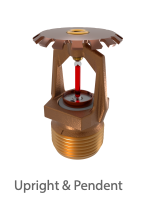In the realm of fire protection systems, extended coverage sprinklers play a crucial role in safeguarding commercial buildings from potential disasters. These specially designed sprinklers are engineered to cover larger areas efficiently, offering enhanced fire suppression capabilities. To comprehend how extended coverage sprinklers function in commercial settings, it’s essential to delve into their mechanics, design principles, and the critical role they play in modern fire safety strategies.
Design and Construction
Extended coverage sprinklers are distinguished by their unique design, which allows them to effectively cover larger areas with water spray. Unlike standard sprinklers, which are typically designed for specific coverage patterns and distances, extended coverage sprinklers are engineered to project water over a more expansive area, which is achieved through the sprinkler’s deflector, a critical component responsible for shaping and directing the water spray.
The deflector, usually a flat or curved plate, is strategically positioned over the sprinkler orifice. When a fire activates the sprinkler, water flows through the orifice and strikes the deflector. The deflector then disperses the water in a specific pattern, covering a wider radius compared to standard sprinklers. This design enables extended coverage sprinklers to effectively protect larger spaces in commercial buildings.
Extended coverage sprinklers are typically available in various finishes and styles to meet the needs of the facility’s aesthetic and overall design. For example, Viking offers a number of finishes in the following sprinkler head styles:
Activation Mechanism
Extended coverage sprinklers, like their conventional counterparts, are activated by heat. Each sprinkler head is equipped with a heat-sensitive element, commonly a glass bulb or a fusible link. When the ambient temperature near the sprinkler reaches a critical point, the heat-sensitive element reacts, causing the glass bulb to shatter or the fusible link to melt. This triggers the sprinkler to release water and commence the fire suppression process.
The activation temperature is carefully calibrated during the installation process to ensure the sprinklers respond appropriately to the specific fire risks associated with the protected area. This precision is essential for preventing false activations and ensuring the sprinklers deploy when genuinely needed.
Hydraulic Calculations
To optimize the performance of extended coverage sprinklers, hydraulic calculations are a crucial aspect of the design process. These calculations consider factors such as water pressure, flow rates, and the layout of the protected space. Engineers use hydraulic analysis to determine the ideal spacing and positioning of sprinkler heads, ensuring uniform coverage across the designated area.
The goal of hydraulic calculations is to deliver the right amount of water to control or suppress a fire effectively. In commercial buildings with extended coverage sprinklers, the system is designed to address the unique challenges posed by diverse spaces, such as open-plan offices, large warehouses, or retail areas. By tailoring the hydraulic calculations to the specific requirements of each space, engineers can enhance the overall effectiveness of the fire protection system.
Code Compliance and Standards
The design and installation of extended coverage sprinklers in commercial buildings must adhere to strict codes and standards set by regulatory authorities. These standards are established to ensure the reliability and performance of fire protection systems, promoting the safety of occupants, and minimizing property damage in the event of a fire.
Spacing is another consideration. There are specific rules and regulations for extended coverage sprinkler spacing and obstructions.
Engineers and contractors involved in the installation of extended coverage sprinklers must be well-versed in the applicable codes, such as those outlined by the National Fire Protection Association (NFPA). Compliance with these codes not only ensures the proper functioning of the sprinkler system but also facilitates coordination with other fire safety measures within the building.
Fire Systems, Inc.
Extended coverage sprinklers represent a critical component of modern fire protection systems in commercial buildings. Their unique design, activation mechanisms, hydraulic calculations, and adherence to codes collectively contribute to their effectiveness in safeguarding large and diverse spaces. As commercial structures continue to evolve in complexity and scale, the role of extended coverage sprinklers becomes increasingly vital in mitigating the potential devastation of fires. By understanding the mechanics behind these sprinklers, building owners, engineers, and fire safety professionals can work collaboratively to enhance the overall resilience of commercial structures against the ever-present threat of fire.
Fire Systems, Inc. is an Atlanta-based fire protection company with over three decades of experience in fire protection. We provide fire sprinkler, suppression, vehicle systems, fire alarm, alarm monitoring, and more. Our experience and expertise allow us to stand as a leader in fire protection. Contact us today at 770-333-7979 or visit our website for more information and access to a free estimate!









